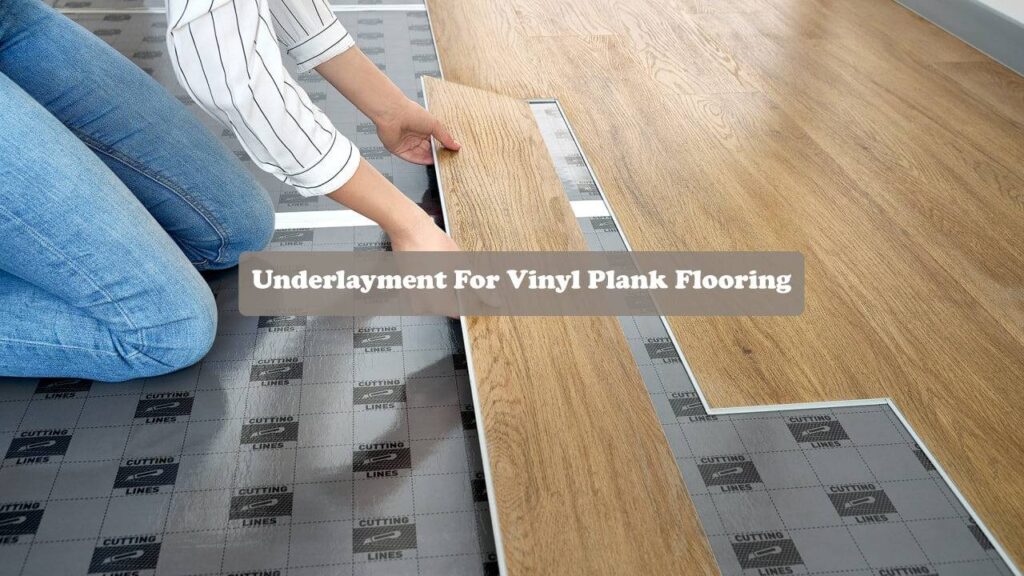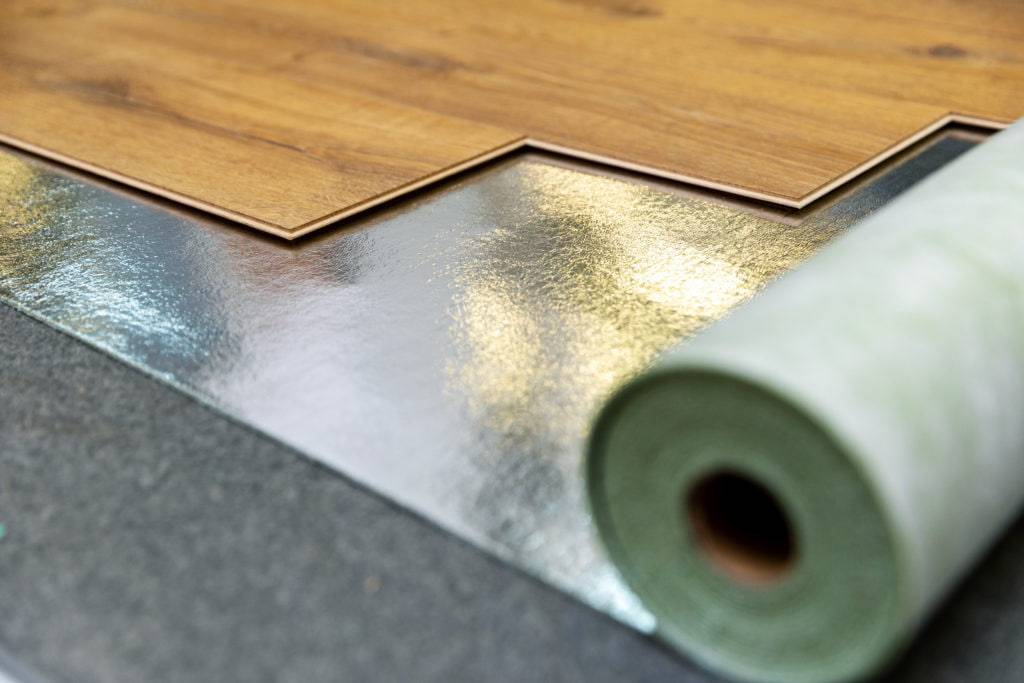You’ve chosen your dream vinyl plank flooring, but hold on before diving into installation. There’s a crucial step often overlooked: selecting the right underlayment. This hidden layer plays a vital role in the longevity and comfort of your new floor.
This guide will equip you with all the knowledge you need to choose the perfect underlayment for your vinyl plank flooring. With the right information, you can avoid installation pitfalls and ensure a beautiful, long-lasting floor.
What is Underlayment?
Before your beautiful vinyl planks grace the floor, there’s a hidden layer playing a critical role: the underlayment. This thin material sits between your subfloor (the existing base layer) and the vinyl planks, forming the foundation of your entire flooring system.
Think of underlayment as a multi-tasking superhero. It:
- Manages Moisture: Underlayment acts as a barrier, protecting your vinyl flooring from moisture that might seep up from the subfloor. This is especially important in areas prone to dampness.
- Muffles the Noise: Enjoy peace and quiet! Underlayment helps deaden sound, reducing both impact noise (footsteps) and airborne noise.
- Boosts Comfort: Underlayment adds a touch of cushion, making your vinyl floor feel softer and more comfortable underfoot.
- Minimizes Deflection: Underlayment helps prevent the floor from bending or sagging under pressure, keeping your vinyl planks looking smooth and even.
Do You Need Underlayment?
While some vinyl planks come with a built-in underlayment (often with moisture protection), most benefit from a separate installation. Installing directly on the subfloor might save you a step initially, but you’ll miss out on the valuable benefits underlayment offers. Consider underlayment as an investment in the longevity, comfort, and overall enjoyment of your new vinyl flooring.
About Underlayment Thickness
You might come across advice suggesting 1-1.5 mm underlayment is ideal for vinyl plank flooring. However, thickness isn’t the only factor to consider. Material density and composition also play a role. To ensure compatibility, consult a flooring specialist with any questions about your specific flooring and underlayment choices.
Double the Underlayment, Double the Trouble?
While instinct might say “more is better,” adding extra underlayment can actually harm your vinyl floor. Here’s why:
- Locking System Strain: Excessive cushioning from double underlayment can put stress on the vinyl planks’ locking system, potentially causing them to separate over time. This can also void your warranty.
- Sticking with the Basics: Most vinyl planks perform best with a single, properly chosen underlayment. This provides optimal support and longevity.
There are exceptions, however. If your vinyl flooring already has a cork underlayment, you might consider adding a very thin moisture barrier – but only if the manufacturer specifically recommends it. Always follow the manufacturer’s instructions to avoid compromising your floor or voiding the warranty.
Underlayment Advantages
Installing underlayment offers a range of advantages that enhance your vinyl floor’s performance:
- Quieter Footsteps: Underlayment acts as a noise reducer, dampening impact sounds like footsteps and dropped objects. While it won’t completely silence your floor, it creates a more peaceful environment.
- Comfort Underfoot: Experience the difference! Underlayment adds a touch of cushion, making your vinyl floor feel softer and more comfortable to walk on.
- Reduced Deflection: Underlayment helps prevent the floor from bending or sagging under pressure, keeping your vinyl planks looking smooth and level. This is especially important at the seams, where deflection can stress the locking mechanism.
- Moisture Protection: Even waterproof vinyl flooring needs protection from moisture that might seep up from the subfloor. Underlayment with a moisture barrier safeguards your floor against potential damage.
- A Touch of Warmth: Underlayment with a thermal R-rating can provide some insulation, making your vinyl floor feel slightly warmer, especially on chilly concrete subfloors. However, for significant warmth improvement, consider alternative flooring materials or installing a radiant heating system.
Underlayment Options: Choosing the Right Fit
Underlayment comes in various materials, each with its own advantages and considerations:
- Cork: A champion of sound absorption, cork excels at noise reduction and can hide minor subfloor imperfections. It pairs well with existing underlayment on vinyl flooring for enhanced soundproofing. However, cork isn’t waterproof and requires a separate moisture barrier, especially on concrete subfloors.
- Foam: A budget-friendly choice, foam offers some cushioning and limited sound dampening. Thicker foam provides better results, but proper installation is crucial to avoid moisture traps and potential mold growth.
- Felt: For superior sound control compared to foam, felt is a popular option. Some felt underlayment comes with a built-in vapor barrier for added moisture protection and offers better insulation than foam or cork.
- Rubber: Seeking sound absorption, warmth, and water resistance? Rubber underlayment delivers on all three. It’s a strong contender, but often comes at a higher price point.
- Plywood and OSB: These provide a stable, level base for vinyl plank flooring, particularly LVP and LVT. However, they don’t offer cushioning or warmth. OSB boasts better durability than plywood.
Choosing the Best Underlayment for Your Vinyl Flooring
While this article provides a variety of underlayment options, the “best” choice depends on your specific needs and priorities. Consider these factors when making your selection:
- Sound Reduction: If noise reduction is a top concern, prioritize underlayment materials like cork or felt, which excel at sound absorption.
- Comfort and Warmth: For a softer feel underfoot and a slight increase in warmth, consider cork, rubber, or thicker foam underlayment.
- Moisture Protection: For areas prone to moisture, choose an underlayment with a built-in vapor barrier, such as felt or some foam underlayments.
- Subfloor Imperfections: If your subfloor has minor imperfections, cork or plywood underlayment can help create a smoother surface.
Final Words
Selecting underlayment for vinyl flooring might seem overwhelming at first. However, by considering a few key factors, you can make an informed decision:
- Understanding Your Needs: Think about your priorities. Do you desire superior soundproofing, increased comfort, or enhanced moisture protection? Different underlayment materials excel in various areas.
- Matching Your Vinyl Flooring: Always refer to the manufacturer’s recommendations for compatible underlayment types and thicknesses. This ensures optimal performance and avoids warranty issues.
- Subfloor Considerations: A smooth, level subfloor is ideal for vinyl plank flooring. Underlayment can help address minor subfloor imperfections, but it’s not a substitute for major repairs.
While underlayment isn’t always mandatory, it offers numerous benefits for your vinyl floor, including increased comfort, noise reduction, and improved moisture protection. By investing in the right underlayment, you’ll contribute to the longevity and overall enjoyment of your beautiful new floor.


